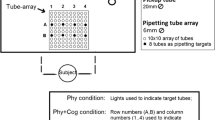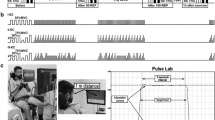Abstract
Six female subjects, aged 24-34 years, performed shoulder-neck exercise for 1 h or until they were exhausted by holding out their arms horizontally at 60° to the sagittal plane. One continuous and six intermittent protocols were applied, all with a mean load corresponding to the torque of the arms, i.e. about 15% maximal voluntary contraction (MVC). The intermittent protocols varied according to cycle time (10 s, 60 s, 360 s) and duty cycle (0.33, 0.50, 0.67, 0.83). Electromyogram (EMG), mean arterial blood pressure (\(\overline {BP}\) a), heart rate (f c) and perceived fatigue were monitored at regular intervals during exercise. Blood concentrations of potassium, lactate and ammonia were determined in pre- and postexercise samples of venous blood. Before and up to 4 h after exercise, measurements were made of MVC, pressure pain threshold, proprioceptive performance, and of EMG, \(\overline {BP}\) a and f c during 1-min arm-holding at 25% MVC. Endurance times ranged from about 10 min to more than 1 h, significantly relating to both cycle time and duty cycle. The \(\overline {BP}\) a, f c EMG amplitude and perceived fatigue increased early during all protocols and continued to increase throughout the exercise period. Duty cycle influenced all of these variables, while only \(\overline {BP}\) a and fatigue perception were related to cycle time. Cardiovascular and neuromuscular recovery was incomplete for hours after several of the protocols, as indicated for example by a sensitizised response to the 1-min armholding. The protocols differed substantially as regards the relationship between different responses. Thus, ranking of the protocols in terms of physiological strain was different, depending on the criterion variable. The result stresses the relevance of applying a comprehensive selection of variables when evaluating the responses to intermittent shoulder-neck exercise.
Similar content being viewed by others
References
Aarås A, Westgaard RH (1987) Further studies of postural load and musculoskeletal injuries of workers at an electro-mechanical assembly plant. Appl Ergon 18:211–219
Bao S, Winkel J, Mathiassen SE, Malmkvist A-K, Parenmark G (1993) EMG activity of the upper trapezius as a function of organization of assembly line work. In: Pedotti A (ed) Proceedings of the ISEK '92 conference. IOS Press, Amsterdam, p 186
Bellemare F, Grassino A (1982) Effect of pressure and timing of contraction on human diaphragm fatigue. J Appl Physiol 53:1190–1195
Bigland-Ritchie B, Woods JJ (1984) Changes in muscle contractile properties and neural control during human muscular fatigue. Muscle Nerve 7:691–699
Bigland-Ritchie B, Furbush F, Woods JJ (1986) Fatigue of intermittent submaximal voluntary contractions: central and peripheral factors. J Appl Physiol 61:421–429
Bjelle A, Hagberg M, Michaelson G (1981) Occupational and individual factors in acute shoulder-neck disorders among industrial workers. Br J Ind Med 38:356–363
Björkstén M, Jonsson B (1977) Endurance limit of force in longterm intermittent static contractions. Scand J Work Environ Health 3:23–27
Boehmer RD (1987) Continuous, real-time, noninvasive monitoring of blood pressure: Peñaz methodology applied to the finger. J Clin Monit 3:282–287
Borg G (1982) Psychophysical bases of perceived exertion. Med Sci Sports Exerc 14:377–381
Byström S (1991) Physiological response and acceptability of isometric intermittent handgrip contractions. Thesis, National Institute of Occupational Health, Stockholm
Byström S, Kilbom A (1990) Physiological response in the forearm during and after isometric intermittent handgrip. Eur J Appl Physiol 60:457–466
Byström S, Sjogaard G (1991) Potassium homeostasis during and following exhaustive submaximal static handgrip contractions. Acta Physiol Scand 142:59–66
Byström S, Mathiassen SE, Fransson-Hall C (1991) Physiological effects of micropauses in isometric handgrip exercise. Eur J Appl Physiol 63:405–411
Christensen H (1986) Muscle activity and fatigue in the shoulder muscles of assembly-plant employees. Scand J Work Environ Health 12:582–587
Christensen H, Fuglsang-Fredriksen A (1988) Quantitative surface EMG during sustained and intermittent submaximal contractions. Electroencephalogr Clin Neurophysiol 70:239–247
Dul J, Douwes M, Smitt P (1991) A work-rest model for static postures. In: Quéinnec Y, Daniellou F (eds) Designing for everyone. Taylor and Francis, London, pp 93–95
Fallentin N (1991) Cardiovascular adjustments to static exercise: neural control mechanisms, muscle fiber composition and electromyographic activity. Thesis, August Krogh Institute, Copenhagen
Fallentin N. Jørgensen K (1992) Blood pressure response to low level static contractions. Eur J Appl Physiol 64:455–459
Fallentin N, Sidenius B, Jørgensen K (1985) Blood pressure, heart rate and EMG in low level static contractions. Acta Physiol Scand 125:265–275
Fallentin N, Jensen BR, Byström S, Jørgensen K (1992) Role of potassium in the reflex regulation of blood pressure during static exercise in man. J Physiol 451:643–651
Gaffney FA, Sjøgaard G, Saltin B (1990) Cardiovascular and metabolic responses to static contraction in man. Acta Physiol Scand 138:249–258
Gardner MJ, Altman DG (1986) Confidence intervals rather than P values: estimation rather than hypothesis testing. BMJ 292:746–750
Gerdle B, Henriksson-Larsén K, Lorentzon R, Wretling M-L (1991) Dependence of the mean power frequency of the electromyogram on muscle force and fibre type. Acta Physiol Scand 142:457–465
Hagberg M (1981) Muscular endurance and surface electromyogram in isometric and dynamic exercise. J Appl Physiol 51:1–7
Hagberg M (1982) Local shoulder muscular strain — symptoms and disorders. J Hum Ergol 11:99–108
Hagberg M, Wegman DH (1987) Prevalence rates and odds ratios of shoulder-neck diseases in different occupational groups. Br J Ind Med 44:602–610
Hägg G (1991) Zero crossing rate as an index of electromyographic spectral alterations and its applications to ergonomics. Thesis, National Institute of Occupational Health, Stockholm
Hägg G, Suurküla J, Liew M (1987) A worksite method for shoulder muscle fatigue measurements using EMG, test contractions and zero crossing technique. Ergonomics 30:1541–1551
Hultén B, Thorstensson A, Sjödin B, Karlsson J (1975) Relationship between isometric endurance and fibre types in human leg muscles. Acta Physiol Scand 93:135–138
Jonsson B (1978) Kinesiology. With special reference to electromyographic kinesiology. Cont Clin Neurophysiol [EEG Suppl] 34:417–428
Jonsson B (1982) Measurement and evaluation of local muscular strain in the shoulder during constrained work. J Hum Ergol 11:73–88
Jonsson B (1988) The static load component in muscle work. Eur J Appl Physiol 57:305–310
Jørgensen K, Fallentin N, Krogh-Lund C, Jensen B (1988) Electromyography and fatigue during prolonged, low-level static contractions. Eur J Appl Physiol 57:316–321
Kilbom Å, Persson J (1981) Circulatory response to static muscle contractions in three different muscle groups. Clin Physiol 1:215–225
Krogh-Lund C, Jørgensen K (1992) Modification of myo-electric power spectrum in fatigue from 15% maximal voluntary contraction of human elbow flexor muscles, to limit of endurance: reflection of conduction velocity variation and/or centrally mediated mechanisms? Eur J Appl Physiol 64:359–370
Lannersten L, Harms-Ringdahl K (1990) Neck and shoulder muscle activity during work with different cash register systems. Ergonomics 33:49–65
Lind AR, Taylor SH, Humphreys PW, Kennely BM, Donald KW (1964) The circulatory effects of sustained voluntary muscle contraction. Clin Sci 27:229–244
Lindman R, Eriksson A, Thornell L-E (1991) Fiber type composition of the human female trapezius: enzyme-histochemical characteristics. Am J Anat 190:385–392
Mathiassen SE, Winkel J (1990) Electromyographic activity in the shoulder-neck region according to arm position and glenohumeral torque. Eur J Appl Physiol 61:370–379
Mathiassen SE, Winkel J (1991) Quantifying variation in physical load using exposure-vs-time data. Ergonomics 34:1455–1468
Mathiassen SE, Winkel J (1992) Can occupational guidelines for work-rest schedules be based on endurance time data? Ergonomics 35:253–259
McKenzie DK, Gandevia SC (1991) Recovery from fatigue of human diaphragm and limb muscles. Respir Physiol 84:49–60
Mitchell JH, Payne FC, Saltin B, Schibye B (1980) The role of muscle mass in the cardiovascular response to static contractions. J Physiol 309:45–54
Müller EA (1935) Der Einfluss von Arbeitsgrösse, Pausenlänge und Pausenverteilung auf die Ermüdung bei statischer Haltearbeit. Arbeitsphysiologie 8:435–445
Öberg T (1992) Trapezius muscle fatigue and electromyographic frequency analysis. Thesis, Linköping University, Linköping
Park SR, Rodbard S (1962) Effects of load and duration of tension on pain induced by muscular contraction. Am J Physiol 203:735–738
Pottier M, Lille F, Phuon M, Monod H (1969) Étude de la contraction statique intermittente. Trav Hum 32:271–284
Rohmert W (1960) Ermittlung von erholungspausen für statische arbeit des menschen. Int Z Angew Physiol Einschl Arbeitsphysiol 18:123–164
Rothman K (1986) Modern epidemiology. Little, Brown, Boston
Sahlin K, Cizinsky S, Warholm M, Högberg J (1992) Repetitive static contractions in humans — a trigger of metabolic and oxidative stress? Eur J Appl Physiol 64:228–236
Salsburg DS (1985) The religion of statistics as practiced in medical journals. Am Stat 39:220–223
Siegel S, Castellan NJ (1988) Nonparametric statistics for the behavioral sciences. McGraw-Hill, New York
Sjøgaard G, Savard G, Juel C (1988) Muscle blood flow during isometric activity and its relation to muscle fatigue. Eur J Appl Physiol 57:327–335
Sundelin G, Hagberg M (1989) The effects of different pause types on neck and shoulder EMG activity during VDU work. Ergonomics 32:527–537
Svensson G, Anfält T (1982) Rapid determination of ammonia in whole blood and plasma using flow injection analysis. Clin Chim Acta 119:7–14
Veiersted KB, Westgaard RH, Andersen P (1990) Pattern of muscle activity during stereotyped work and its relation to muscle pain. Int Arch Occup Environ Health 62:31–41
Viitasalo JT, Komi PV (1981) Effects of fatigue on isometric force- and relaxation-time characteristics in human muscle. Acta Physiol Scand 111:87–95
Vøllestad NK, Sejersted OM, Bahr R, Woods JJ, Bigland-Ritchie B (1988) Motor drive and metabolic responses during repeated submaximal contractions in humans. J Appl Physiol 64:1421–1427
Vøllestad NK, Wesche J, Sejersted OM (1990) Gradual increase in leg oxygen uptake during repeated submaximal contractions in humans. J Appl Physiol 68:1150–1156
Westgaard RH (1988) Measurement and evaluation of postural load in occupational work situations. Eur J Appl Physiol 57:291–304
Winkel J (1987) On the significance of physical activity in sedentary work. In: Knave B, Widebäck P-G (eds) Work with display units 1986. Elsevier, North Holland, pp 229–236
Winkel J, Oxenburgh M (1990) Towards optimizing physical activity in VDT/office work. In: Sauter SL, Dainoff M, Smith M (eds) Promoting health and productivity in the computerized office. Taylor and Francis, London, pp 94–117
Winkel J, Westgaard R (1992) Occupational and individual risk factors for shoulder-neck complaints, II. The scientific basis (literature review) for the guide. Int J Ind Ergon 10:85–104
Author information
Authors and Affiliations
Rights and permissions
About this article
Cite this article
Mathiassen, S.E. The influence of exercise/rest schedule on the physiological and psychophysical response to isometric shoulder-neck exercise. Europ. J. Appl. Physiol. 67, 528–539 (1993). https://doi.org/10.1007/BF00241650
Accepted:
Issue Date:
DOI: https://doi.org/10.1007/BF00241650




